How did the Supreme Court start housing planning for Dhaka’s poor?
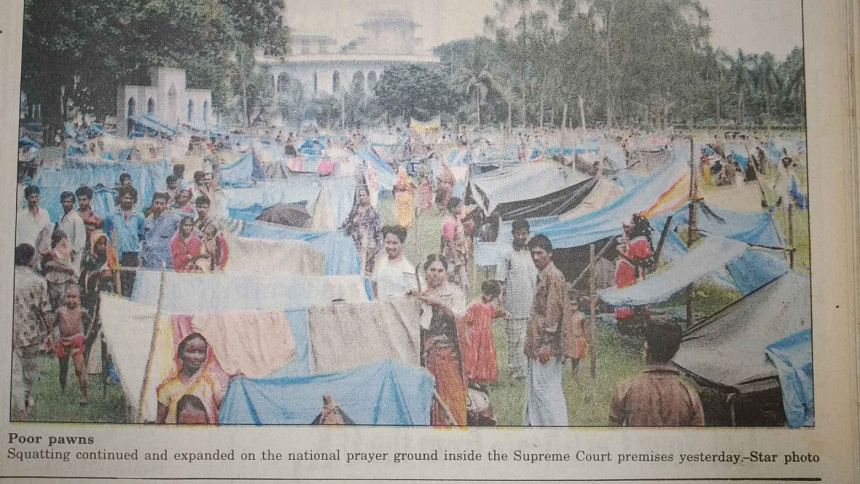
On August 20, 1999, over 5,000 slum dwellers mobilised from various informal settlements in Dhaka and gathered in the Supreme Court premises to protest the "wholesale eviction" that was underway that year. The government had launched the Ghore Fera programme, a scheme to support reverse migration to villages. With Ghore Fera underway, the government decided to clear the slums altogether. Dwellers rallied and raised slogans against evictions and demanded resettlement with dignity. At least 1,500 dwellers camped in the Supreme Court premises for the next six days. In the Supreme Court, the judges were deciding on what has come to be known as a landmark case on Bangladesh's informal settlements, Ain O Salish Kendra (ASK) and Ors vs the Government of Bangladesh and Ors (1999) 19 BLD 488—hereafter, ASK v BD (1999). Under pressure, the judges halted the eviction and recognised the slum dwellers' right to protection from evictions without resettlement. The verdict was a win for organised dwellers.
The resulting judgment has since been the basis of anti-eviction advocacy in Bangladesh. By staying the evictions and keeping settlements in place, the Supreme Court of Bangladesh has since been playing a crucial role in Dhaka's urban governance and planning. This role of the court has been no less than a de facto planning facilitator for the settlement dwellers as the judicial interventions have protected the dwellers' lives, enabled them to pursue livelihoods, and responded to their claims for right to the capital city.
The court's progressive stance against eviction without resettlement has also percolated upwards. Planners and policymakers for the urbanisation of Bangladesh increasingly recognise the need to include the needs of historically marginalised settlement dwellers in planning processes. Rajhdhani Unnayan Katripakkha's (Rajuk) new Detailed Area Plan (DAP) affirms the importance of low-income settlements and recognises the need for an inclusionary approach to settlements. The National Housing Policy, 2016 acknowledges the importance of resettlements in case of evictions and urges a shift in perspective towards settlement dwellers. Although insufficient in tackling the housing crisis, government programmes such as Ghore Fera (Back to Home), Asroyon (Village Shelter Programme), and Adorsho Gram (Ideal Village Project) have been launched as flagship projects.
How did the court adopt a pro-housing interpretation of the constitution? What are the possibilities and limitations of the court's activist approach? As professional planning authorities continue to marginalise settlement dwellers, these questions must be looked into to make Dhaka's housing planning equity-focused and participatory. Lessons from the struggle and progress so far of housing advocates and grassroots groups can be instructive to advance housing justice in urban Bangladesh.
Planning for settlements through PIL jurisprudence
Over the past decades, several evictions have taken place on a grand scale, and that exclusionary urban development model persists to this day. Rights organisations and slum dwellers resorted to writ petitions to combat such evictions at the Supreme Court. Taltola Sweeper Colony (in Gulshan area) Demolition case, the first writ petition of its kind filed with the High Court, challenged settlement eviction back in 1989. When the demolition began and shanties were being bulldozed, the eviction process led to the death of a child. Major political parties, as well as rights and citizen groups, protested the eviction. Upon hearing the writ, the court initially gave orders in favour of the slum dwellers. However, the court only awarded a stay order.
In the years following, Public Interest Litigation (PIL) jurisprudence developed in Bangladesh. Equipped with PILs, rights organisations guarded the right to shelter of the informal settlers. Unlike individual writs, PILs can be initiated by petitioners not directly aggrieved in a situation. Prior to PILs, it was generally accepted that only the aggrieved person had legitimate standing at the court to claim a remedy. The concept of PIL enables a person or authority not aggrieved directly to come before the court to claim remedy. In Bangladesh, Dr Mohiuddin Farooqe vs Bangladesh (1995) 49 DLR (AD) 1 set out the PIL jurisprudence. The court held that a "person aggrieved" does not mean only a person aggrieved personally, but also one whose "heart bleeds" for the aggrieved persons. That case marked the commencement of the PIL era in Bangladesh. PILs were well-suited for housing activists and rights organisations as the question of standing would not bar them anymore. In the following years, shelter justice organisations filed a number of PILs to challenge evictions.
The landmark ASK vs BD (1999) is perhaps the first PIL to challenge eviction. But the 1999 PIL went beyond challenging eviction. The 1999 case resulted in the High Court making a series of observations for the government to follow a guideline in case of slum eviction. In this judgment, the High Court established two principles: i) The protection of slum dwellers from forced evictions is integral to their right to life and livelihood; and ii) An alternative accommodation must be ensured before eviction. The guideline set out in this case paved the way for settlement dwellers, housing right activists and rights organisations to access the court more frequently to confront eviction. In the 2000s, several cases resulted in the courts granting stay orders in favour of settlement dwellers and stalled large-scale evictions like the ones in the previous decade.
Using PILs to advance grassroots struggles and contest evictions is unique in the case of Bangladesh. The PILs in Bangladesh have been driven by residents, community associations, and advocacy groups. Here, the PILs were used to stay eviction orders, pass injunctions for fair resettlement, and encourage a participatory approach to settlement planning. The constitution has been interpreted progressively in favour of the settlement dwellers through these PILs. The Supreme Court has construed the right to shelter as an integral part of right to life (Article 32). Such broad interpretation by the court in these PILs has provided a crucial foundation for building the housing right jurisprudence in Bangladesh.
In cases where PILs were creative and successful, PIL jurisprudence has facilitated in creating multi-stakeholder participatory spaces. In the ongoing case regarding Korail where ASK, BLAST and Brac are all involved, for example, the court has directed a collaborative approach to resettlement of Korail's dwellers. Beyond issuing an eviction stay order, the court initiated an open-ended "planning" process, requiring the state, developers, and Korail's residents to support and monitor a viable resettlement solution. The PIL has opened up a deliberative space for fact-sharing, housing policy debate, and forward-looking policy proposals for settlements. Whether deliberations reach a fruitful decision or not, the PILs generated a sense of agency among residents.
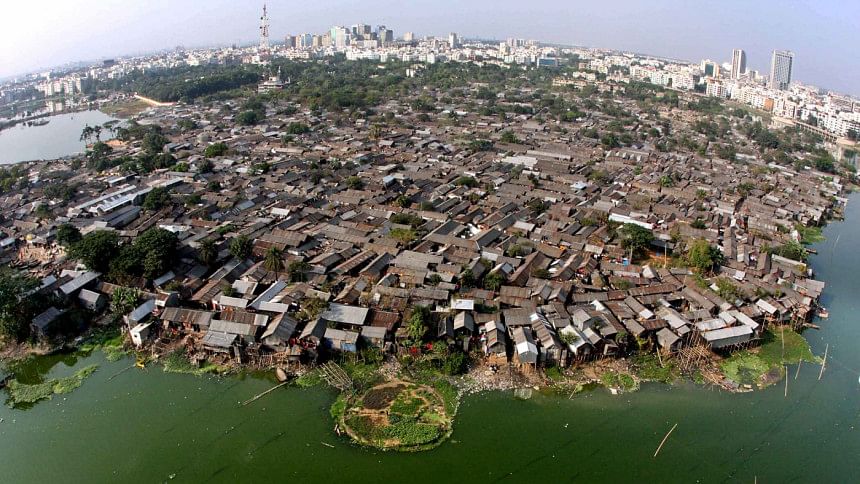
The limits of PILs
PIL jurisprudence can only go so far. Since no laws establish duties on government or private bodies to construct social housing and safeguard against evictions, settlements threatened with eviction remain vulnerable to the court's unfavourable interpretations. Therefore, in a few subsequent cases, the court tended to interpret in support of eviction.
There are also limitations in the court proceedings. Since settlement dwellers squatting on government land don't have legal ownership of the land, they are depicted as "unauthorised occupants." The concept of "unauthorised occupants" is premised on the idea that property owners are the only entities deemed worthy of protection by the court. The 30-day notice requirement, which the court uses to stay evictions where notices have not been properly served, doesn't apply to dwellers living on private land. Moreover, in the 1999 PIL, the court held that service of proper notice to the settlement dwellers was not possible due to their "floating" nature and lack of permanent address. The court also often refers to the fact that Bangladesh is party to a host of international commitments and conventions on securing housing rights for settlement dwellers. But till date, no laws exist to make these conventions legally binding in the country.
Apartments will not solve housing injustice
The resettlement option advanced by the courts might be reaching a dead end at present. Recently, the government created and rented out resettlement housing to settlement dwellers in Mirpur. Many are welcoming the apartment rentals as an exemplary approach to solving the urban poor's housing crisis. The 14-storey apartment buildings will provide over 500 serviced units. But when the flats were inaugurated in 2021, many of Mirpur's settlement dwellers refused to move into these apartments, because the rents were more than what people could afford. One dweller concisely pointed out, "I earn Tk 8,000 per month, and can't manage food and other needs with that. How will I pay Tk 4,000 per month for the flat?" With rising prices of basic necessities and under a pandemic-impacted economy, the economic precarity is ever more cruel on low-income settlement dwellers.
Besides, it is now well understood in urban policy and research that the "provide everybody apartments" approach to solve the housing crisis only looks good on paper. Low-income settlements are not just residential areas, but also places of livelihood, trading, community, and myriad activities that support life in the urban margins, such as farming and recycling. An apartment building by design often destroys a sense of community, the long-accumulated social capital of dwellers, opportunities for work on site, and the possibilities for other productive activities, like farming. The Global South's experience with the apartment approach in countries like Thailand and India show that simply providing rental or loan-backed apartments is futile. Factors like site location, compensation, building designs, as well as pre- and post-resettlement participation and empowerment of settlement communities are more important than allocation of the physical apartment themselves. Even in terms of sheer numbers, over 500 apartments are a drop in the bucket for the millions of apartment units we will need. Along with building apartments, the government will also have to make sure that the settlement dwellers are meaningfully included in the process of their resettlement. In sum, "provide everybody apartments" may be an ideologically useful tactic to justify settlement evictions, but this approach is deeply flawed and impractical for Bangladesh's cities.
Will the other planners please stand up?
But why must the court be the primary lifeline of settlement dwellers? What are the roles of entities like Rajuk, the city corporations, and the National Housing Authority? Professional planning entities acknowledge but have not meaningfully acted on the fact that settlement dwellers are deeply embedded in the life of urban Bangladesh. Settlement dwellers make places liveable, shape the urban fabric, and sustain a growing economy. They do this almost invisibly and under a perpetual threat of eviction, unable to live fully and with dignity. Often more concerned with landowners' interests, professional planning authorities use dwellers' lack of land ownership as an alibi for excluding settlements from planning processes. In this way, planning authorities place settlement dwellers in zones of illegalised citizenship. That is, settlement dwellers are symbolically included (or even celebrated) as contributing to the city as citizens. But they are materially excluded on grounds of their illegal tenure. The predicament of settlement dwellers shows how the Bangladeshi state for the most part—and despite espousing commitments to solving the housing crisis—is far away from its landless and non-owning class of citizens. It also indicates that no matter how PIL jurisprudence has developed, ultimately the judicial approach is too weak to make transformative changes.
We need to broaden the conversation on housing justice from constitutional debates to popular demands for the cities our most vulnerable communities want. We also need to step beyond a technocratic language of institutional coordination and all of the niceties that sidestep the moral question at stake: Do we or do we not see settlement dwellers as equal citizens with the right to pursue their urban desires? Community groups and advocacy organisers need to strengthen their network across our cities and organise proactively against housing injustice, which should also include the housing precarity of apartment renters and small landowners. Residents, community organisers, lawyers, planners, professionals—anyone can initiate and take such steps. In the 21st century, urban planning is no more the sole prerogative of professional planners. As we organise and generate a popular pressure for housing justice, the PILs and a more rigorous housing law framework can be crucial tools along the way, but not the end of the road.
Over the past decades, the courts responded to the ministries and planning authorities' exclusionary urban planning processes by attempting to create more participatory grassroots approaches to settlement planning in our cities. Their effort has led to a delicate PIL jurisprudence to stay evictions, but this does not fundamentally transform our urban approach to settlement planning. As the number of settlements multiplies across our cities, particularly in the intensification of climate-related migrations, we need deep restructuring in the way we look at settlement dwellers. We need to recognise the indispensability and value of settlement dwellers' labour, community, knowledge, and dreams for arriving at a humane Bangladeshi urbanism. We need to invest resources, integrate the settlements into mainstream city planning, and create participatory planning processes for sustaining and upgrading the liveable places that dwellers have created over the decades.
Dr Efadul Huq is co-convener of Najjo Abashon Moncho and assistant professor of environmental science and policy at Smith College in Massachusetts, US.
Jahid Oyon is a research associate at Najjo Abashon Moncho and studying law at Jahangirnagar University, Bangladesh.

 For all latest news, follow The Daily Star's Google News channel.
For all latest news, follow The Daily Star's Google News channel. 


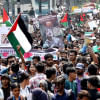

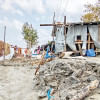


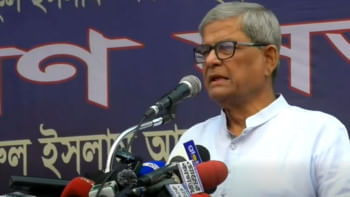
Comments